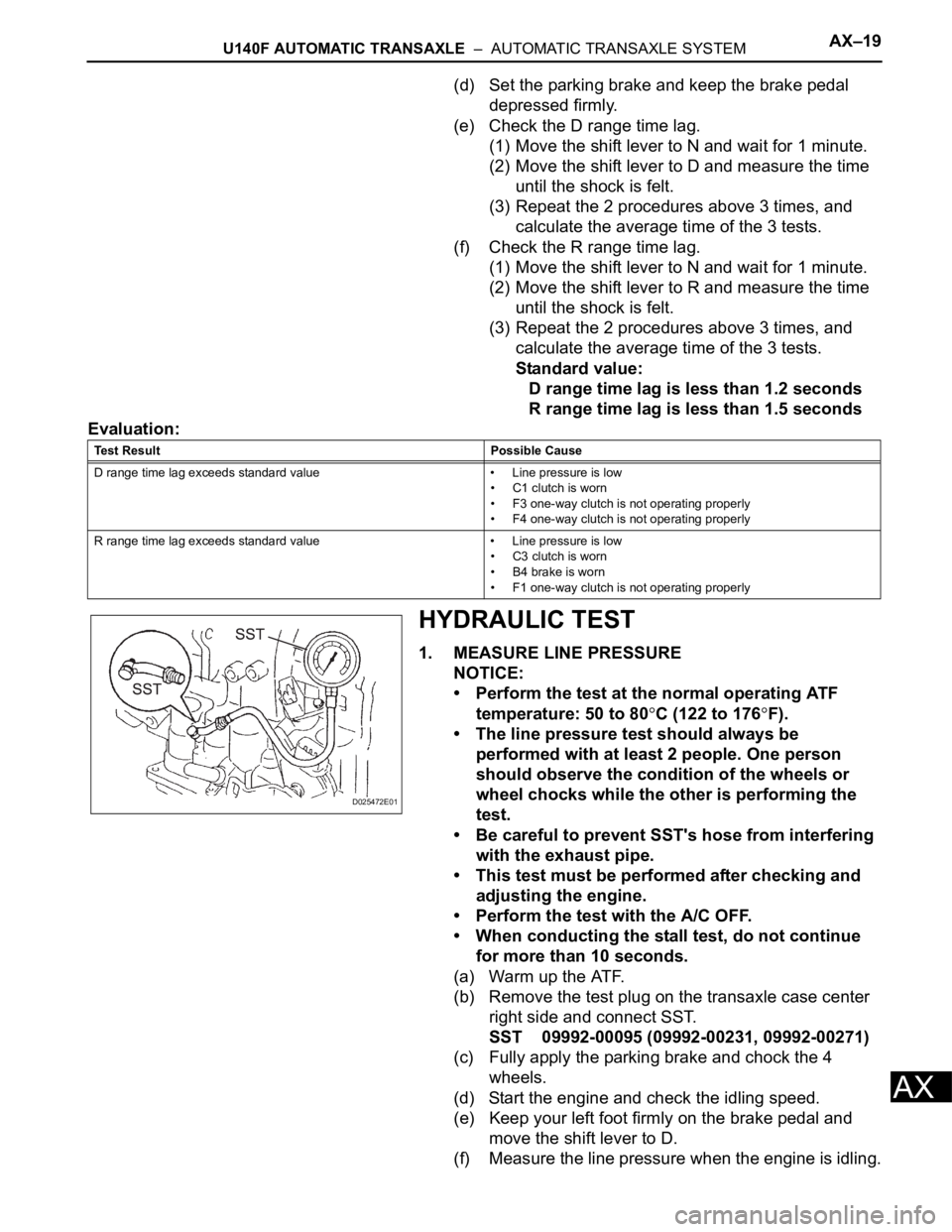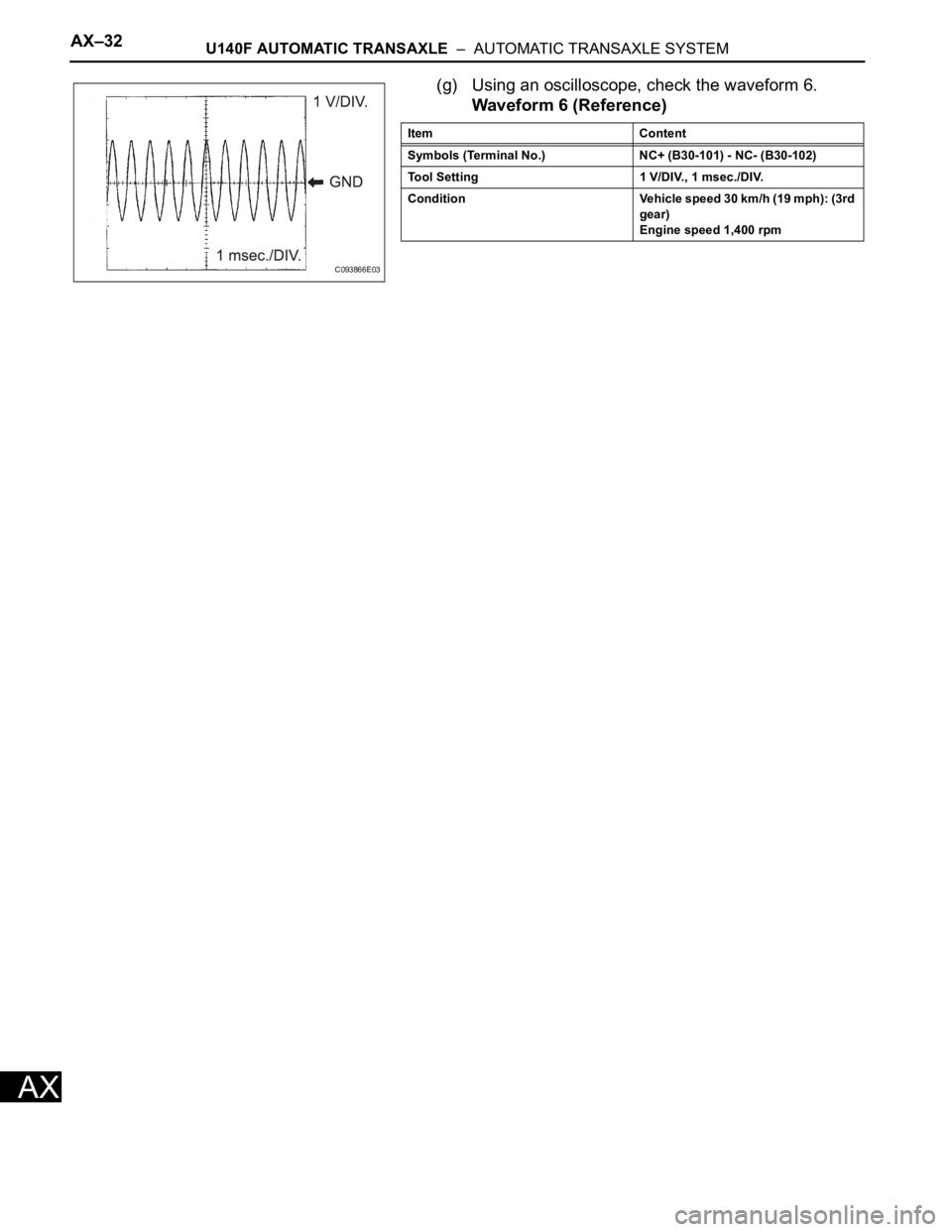check engine TOYOTA RAV4 2006 Service Repair Manual
[x] Cancel search | Manufacturer: TOYOTA, Model Year: 2006, Model line: RAV4, Model: TOYOTA RAV4 2006Pages: 2000, PDF Size: 45.84 MB
Page 930 of 2000

2GR-FE CHARGING – CHARGING SYSTEMCH–7
CH
8. INSPECT CHARGING CIRCUIT WITH LOAD
(a) With the engine running at 2,000 rpm, turn the high
beam headlights ON and turn the heater blower
switch to the "HI" position.
(b) Check the reading on the ammeter.
Standard amperage:
30 A or more
If the ammeter reading is less than the standard
amperage, repair the generator.
HINT:
If the battery is fully charged, the indication will
sometimes be less than the standard amperage.
If this is the case, add more electrical load (operate
the wipers, rear window defogger, etc.) and check
the reading on the ammeter again.
Page 949 of 2000

U140F AUTOMATIC TRANSAXLE – AUTOMATIC TRANSAXLE SYSTEMAX–15
AX
ROAD TEST
1. PROBLEM SYMPTOM CONFIRMATION
(a) Based on the result of the customer problem
analysis, try to reproduce the symptoms. If the
problem is that the transaxle does not shift up, shift
down, or the shift point is too high or too low,
conduct the following road test referring to the
automatic shift schedule and simulate the problem
symptoms.
2. ROAD TEST
NOTICE:
Perform the test at the normal operating ATF
temperature of 50 to 80
C (122 to 176F).
(a) D position test
Move the shift lever to D and fully depress the
accelerator pedal. Check the following:
(1) Check up-shift operation.
Check that the 1
2, 2 3 and 3 O/D up-
shifts take place at the shift point shown in the
automatic shift schedule (see page SS-55).
HINT:
O/D Gear Up-shift Prohibition Control
• Engine coolant temperature is 55
C (131F)
or less and vehicle speed is at 70 km/h (43
mph) or less.
• ATF temperature is 5
C (41F) or less.
O/D Gear Lock-up Prohibition Control
• Brake pedal is depressed.
• Accelerator pedal is released.
• Engine coolant temperature is 60
C (140F)
or less.
(2) Check for shift shock and slip.
Check for shock and slip at the 1
2, 2 3 and
3
O/D up-shifts.
(3) Check for abnormal noise and vibration.
Check for abnormal noise and vibration when
up-shifting from 1
2, 2 3 and 3 O/D while
driving with the shift lever on D, and check while
driving in the lock-up condition.
HINT:
The check for the cause of abnormal noise and
vibration must be done thoroughly as it could
also be due to loss of balance in the differential,
torque converter clutch, etc.
(4) Check kick-down operation.
While driving the vehicle in the 2nd, 3rd and O/D
gears with the shift lever on D, check that the
possible kick-down vehicle speed limits for 2
1, 3
2 and O/D 3 kick-downs conform to
those indicated in the automatic shift schedule
(see page SS-55).
(5) Check for abnormal shock and slip at kick-down.
Page 950 of 2000

AX–16U140F AUTOMATIC TRANSAXLE – AUTOMATIC TRANSAXLE SYSTEM
AX
(6) Check the lock-up mechanism.
• Drive the vehicl e in the O/D gear with the shift
lever on D. Maintain a steady speed (lock-up
ON).
• Lightly depress the accelerator pedal and
check that the engine speed does not change
abruptly.
HINT:
• There is no lock-up function in the 1st and
2nd gear.
• If there is a sudden increase in engine speed,
there is no lock-up.
(b) 3 position test
Move the shift lever to 3 and fully depress the
accelerator pedal. Check the following:
(1) Check up-shift operation.
Check that the 1
2 and 2 3 up-shifts take
place and that the shift point conforms to the
automatic shift schedule (see page SS-55).
(2) Check engine braking.
While driving the vehicle in the 3rd gear with the
shift lever on 3, release the accelerator pedal
and check the engine braking effect.
(3) Check for abnormal noises during acceleration
and deceleration, and for shock at up-shift and
down-shift.
(c) 2 position test
Move the shift lever to 2 and fully depress the
accelerator pedal. Check the following:
(1) Check up-shift operation.
Check that the 1
2 up-shift takes place and
that the shift point conforms to the automatic
shift schedule (see page SS-55).
HINT:
There is no O/D up-shift and lock-up when the
shift lever is on 2.
(2) Check engine braking.
While driving the vehicle in the 2nd gear with the
shift lever on 2, release the accelerator pedal
and check the engine braking effect.
(3) Check for abnormal noises during acceleration
and deceleration, and for shock at up-shift and
down-shift.
(d) L position test
Move the shift lever to L and fully depress the
accelerator pedal. Check the following:
(1) Check that there is no up-shift.
While driving the vehicle with the shift lever on L,
check that there is no up-shift to 2nd gear.
HINT:
There is no lock-up in L.
Page 951 of 2000

U140F AUTOMATIC TRANSAXLE – AUTOMATIC TRANSAXLE SYSTEMAX–17
AX
(2) Check engine braking.
While driving the vehicle with the shift lever on L,
release the accelerator pedal and check the
engine braking effect.
(3) Check for abnormal noises during acceleration
and deceleration.
(e) R position test
Move the shift lever to R and lightly depress the
accelerator pedal. Check that the vehicle moves
backward without any abnormal noise or vibration.
CAUTION:
Before conducting this test, ensure that no
people or obstacles are in the test area.
(f) P position test
Stop the vehicle on an incline (more than 5
). Then
move the shift lever to P and release the parking
brake. Check that the parking lock pawl holds the
vehicle in place.
Page 952 of 2000

AX–18U140F AUTOMATIC TRANSAXLE – AUTOMATIC TRANSAXLE SYSTEM
AX
MECHANICAL SYSTEM TESTS
1. STALL SPEED TEST
HINT:
This test is to check the overall performance of the
engine and transaxle.
NOTICE:
• Do not perform the stall speed test longer than 5
seconds.
• To ensure safety, perform this test in an open and
level area that provides good traction.
• The stall speed test should always be performed
with at least 2 people. One person should observe
the condition of the wheels and wheel chocks
while the other is performing the test.
(a) Connect the intelligent tester to the CAN VIM. Then
connect the CAN VIM to the DLC3.
(b) Run the vehicle until the transmission fluid
temperature has reached 50 to 80
C (122 to 176F).
(c) Allow the engine to idle with the air conditioning
OFF.
(d) Chock all 4 wheels.
(e) Set the parking brake and keep the brake pedal
depressed firmly with your left foot.
(f) Move the shift lever to the D position.
(g) Depress the accelerator pedal as much as possible
with your right foot.
(h) Read the engine rpm (stall speed) and release the
accelerator pedal immediately.
Standard value:
2,150 to 2,450 rpm
Evaluation:
NOTICE:
Perform the test at the normal operating ATF
temperature of 50 to 80
C (122 to 176F).
2. SHIFT TIME LAG TEST
HINT:
This test is to check the condition of the direct clutch,
forward clutch, 1st brake and reverse brake.
(a) Connect the intelligent tester to the CAN VIM. Then
connect the CAN VIM to the DLC3.
(b) Run the vehicle until the transmission fluid
temperature has reached 50 to 80
C (122 to 176F).
(c) Allow the engine to idle with the air conditioning
OFF.
Test Result Possible Cause
Stall speed is lower than standard value • Stator one-way clutch is not operating properly
• Torque converter is faulty (stall speed is less than standard value
by 600 rpm or more)
• Engine power may be insufficient
Stall speed is higher than standard value • Line pressure is low
• C1 clutch slipping
• F3 one-way clutch is not operating properly
• F4 one-way clutch is not operating properly
Page 953 of 2000

U140F AUTOMATIC TRANSAXLE – AUTOMATIC TRANSAXLE SYSTEMAX–19
AX
(d) Set the parking brake and keep the brake pedal
depressed firmly.
(e) Check the D range time lag.
(1) Move the shift lever to N and wait for 1 minute.
(2) Move the shift lever to D and measure the time
until the shock is felt.
(3) Repeat the 2 procedures above 3 times, and
calculate the average time of the 3 tests.
(f) Check the R range time lag.
(1) Move the shift lever to N and wait for 1 minute.
(2) Move the shift lever to R and measure the time
until the shock is felt.
(3) Repeat the 2 procedures above 3 times, and
calculate the average time of the 3 tests.
Standard value:
D range time lag is less than 1.2 seconds
R range time lag is less than 1.5 seconds
Evaluation:
HYDRAULIC TEST
1. MEASURE LINE PRESSURE
NOTICE:
• Perform the test at the normal operating ATF
temperature: 50 to 80
C (122 to 176F).
• The line pressure test should always be
performed with at least 2 people. One person
should observe the condition of the wheels or
wheel chocks while the other is performing the
test.
• Be careful to prevent SST's hose from interfering
with the exhaust pipe.
• This test must be performed after checking and
adjusting the engine.
• Perform the test with the A/C OFF.
• When conducting the stall test, do not continue
for more than 10 seconds.
(a) Warm up the ATF.
(b) Remove the test plug on the transaxle case center
right side and connect SST.
SST 09992-00095 (09992-00231, 09992-00271)
(c) Fully apply the parking brake and chock the 4
wheels.
(d) Start the engine and check the idling speed.
(e) Keep your left foot firmly on the brake pedal and
move the shift lever to D.
(f) Measure the line pressure when the engine is idling.
Test Result Possible Cause
D range time lag exceeds standard value • Line pressure is low
• C1 clutch is worn
• F3 one-way clutch is not operating properly
• F4 one-way clutch is not operating properly
R range time lag exceeds standard value • Line pressure is low
• C3 clutch is worn
• B4 brake is worn
• F1 one-way clutch is not operating properly
D025472E01
Page 960 of 2000

AX–26U140F AUTOMATIC TRANSAXLE – AUTOMATIC TRANSAXLE SYSTEM
AX
PROBLEM SYMPTOMS TABLE
HINT:
• Use the table below to help determine the cause of the
problem symptom. The potential causes of the symptoms
are listed in order of probability in the "Suspected area"
column of the table. Check each symptom by checking the
suspected areas in the order they are listed. Replace parts
as necessary.
• The Matrix Chart is divided into 2 chapters. When
troubleshooting, check Chapter 1 first. If instructions are
given in Chapter 1 to proceed to 2, proceed as instructed.
• If the instruction "Proceed to next circuit inspection shown
in problem symptoms table" is given in the flowchart for
each circuit, proceed to the next suspected area in the
table.
• If the problem still occurs even though there are no
malfunctions in any of the circuits, check the ECM and
replace it if necessary.
CHAPTER 1: ELECTRICAL CIRCUIT MATRIX CHART
HINT:
*: When the circuit is defective, a DTC may be output.
CHAPTER 2: ON-VEHICLE REPAIR AND OFF-VEHICLE REPAIR
Symptom Suspected area See page
No up-shift (1st -> 2nd) ECMIN-37
No up-shift (2nd -> 3rd) ECMIN-37
No up-shift (3rd -> O/D)1. Park/Neutral position switch circuit*AX-39
2. ECMIN-37
No down-shift (O/D -> 3rd) ECMIN-37
No down-shift (3rd -> 2nd) ECMIN-37
No down-shift (2nd -> 1st) ECMIN-37
No lock-up or no lock-up off ECMIN-37
Shift point too high or too low ECMIN-37
Up-shift to O/D from 3rd while shift lever is on 31. Park/Neutral position switch circuit*AX-39
2. ECMIN-37
Up-shift to O/D from 3rd while engine is cold1. Engine coolant temp. sensor circuit*ES-51
2. ECMIN-37
Harsh engagement (N -> D) ECMIN-37
Harsh engagement (lock-up) ECMIN-37
Harsh engagement (any driving position) ECMIN-37
Poor acceleration ECMIN-37
Engine stalls when starting off or stopping ECMIN-37
Malfunction in shifting1. Park/Neutral position switch circuit*AX-39
2. ECMIN-37
Symptom Suspected area See page
Vehicle does not move in all positions other than P and
N1. Manual valveAX-155
2. Primary regulator valveAX-155
3. Front and rear planetary gearAX-155
4. U/D planetary gearAX-155
5. F2 U/D one-way clutchAX-155
6. C1 forward clutchAX-155
7. B3 U/D brakeAX-155
Page 965 of 2000

U140F AUTOMATIC TRANSAXLE – AUTOMATIC TRANSAXLE SYSTEMAX–31
AX
(b) Using an oscilloscope, check the waveform 1.
Waveform 1 (Reference)
(c) Using an oscilloscope, check the waveform 2.
Waveform 2 (Reference)
(d) Using an oscilloscope, check the waveform 3.
Waveform 3 (Reference)
(e) Using an oscilloscope, check the waveform 4.
Waveform 4 (Reference)
(f) Using an oscilloscope, check the waveform 5.
Waveform 5 (Reference)
G023426E03
Item Content
Symbols (Terminal No.) SL1+ (B30-57) - SL1- (B30-77)
Tool Setting 5 V/DIV., 1 msec./DIV.
Condition Engine idle speed
G023426E03
Item Content
Symbols (Terminal No.) SL2+ (B30-58) - SL2- (B30-59)
Tool Setting 5 V/DIV., 1 msec./DIV.
Condition Engine idle speed
C133935E01
Item Content
Symbols (Terminal No.) DSL (B30-79) - E01 (B30-45)
Tool Setting 10 V/DIV., 100 msec./DIV.
Condition Vehicle speed 65 km/h (40 mph),
lock-up (ON to OFF)
G023426E03
Item Content
Symbols (Terminal No.) SLT+ (B30-76) - SLT- (B30-75)
Tool Setting 5 V/DIV., 1 msec./DIV.
Condition Engine idle speed
C053419E02
Item Content
Symbols (Terminal No.) NT+ (B30-125) - NT- (B30-124)
Tool Setting 5 V/DIV., 0.5 msec./DIV.
Condition Vehicle speed 20 km/h (12 mph)
Page 966 of 2000

AX–32U140F AUTOMATIC TRANSAXLE – AUTOMATIC TRANSAXLE SYSTEM
AX
(g) Using an oscilloscope, check the waveform 6.
Waveform 6 (Reference)
C093866E03
Item Content
Symbols (Terminal No.) NC+ (B30-101) - NC- (B30-102)
Tool Setting 1 V/DIV., 1 msec./DIV.
Condition Vehicle speed 30 km/h (19 mph): (3rd
gear)
Engine speed 1,400 rpm
Page 967 of 2000

U140F AUTOMATIC TRANSAXLE – AUTOMATIC TRANSAXLE SYSTEMAX–33
AX
DIAGNOSIS SYSTEM
1. DESCRIPTION
(a) When troubleshooting On-Board Diagnostic (OBD
II) vehicles, the vehicle must be connected to the
OBD II scan tool (complying with SAE J1987).
Various data output from the vehicle's ECM can
then be read.
(b) OBD II regulations require that the vehicle's on-
board computer illuminates the Malfunction
Indicator Lamp (MIL) on the instrument panel when
the computer detects a malfunction in:
(1) The emission control system/components
(2) The powertrain control components (which affect
vehicle emissions)
(3) The computer
In addition, the applicable Diagnostic Trouble
Codes (DTCs) prescribed by SAE J2012 are
recorded in the ECM memory.
When the malfunction does not reoccur, the MIL
stays illuminated until the ignition switch is
turned OFF, and the MIL turns OFF when the
engine is started. However, the DTCs remain
recorded in the ECM memory.
(c) To check DTCs, connect the intelligent tester to the
Data Link Connector 3 (DLC3) of the vehicle. The
tester displays DTCs, the freeze frame data and a
variety of the engine data.
The DTCs and freeze frame data can be erased
with the tester (see page AX-29).
2. NORMAL MODE AND CHECK MODE
(a) The diagnosis system operates in "normal mode"
during normal vehicle use. In normal mode, "2 trip
detection logic" is used to ensure accurate detection
of malfunctions. "Check mode" is also available to
technicians as an option. In check mode, "1 trip
detection logic" is used for simulating malfunction
symptoms and increasing the system's ability to
detect malfunctions, including intermittent
malfunctions.
3. 2 TRIP DETECTION LOGIC
(a) When a malfunction is first detected, the
malfunction is temporarily stored in the ECM
memory (1st trip). If the same malfunction is
detected during the next drive cycle, the MIL is
illuminated (2nd trip).
FI00534E01
B127989E02